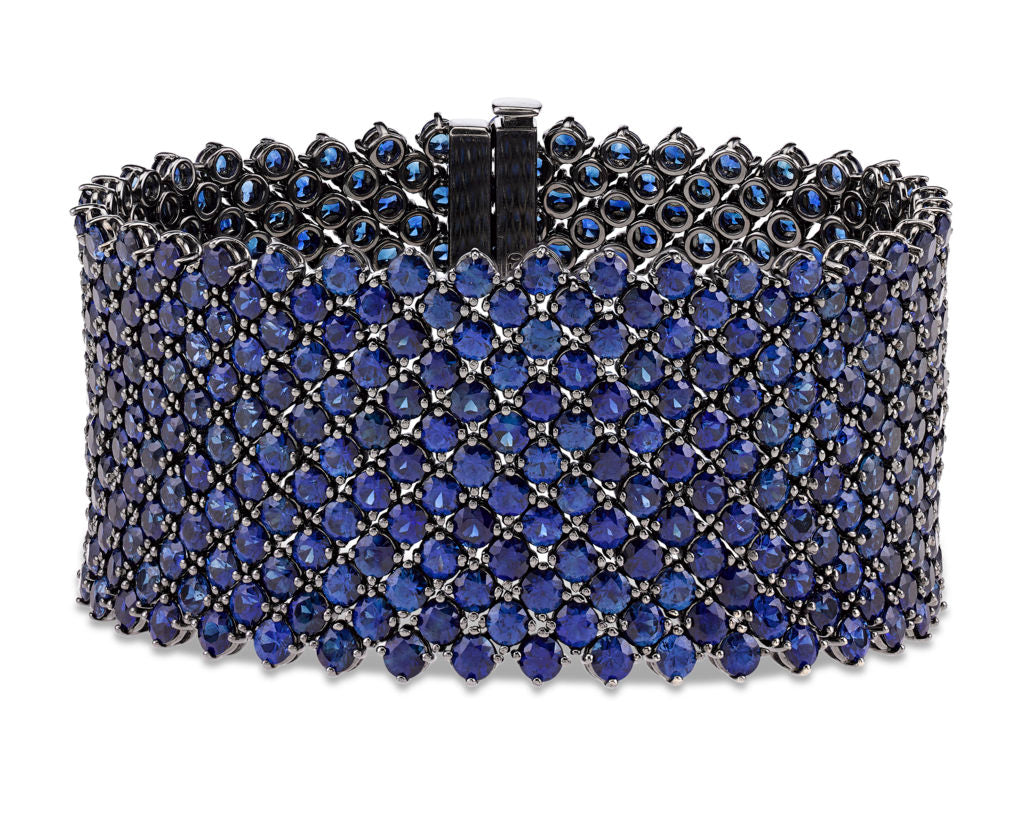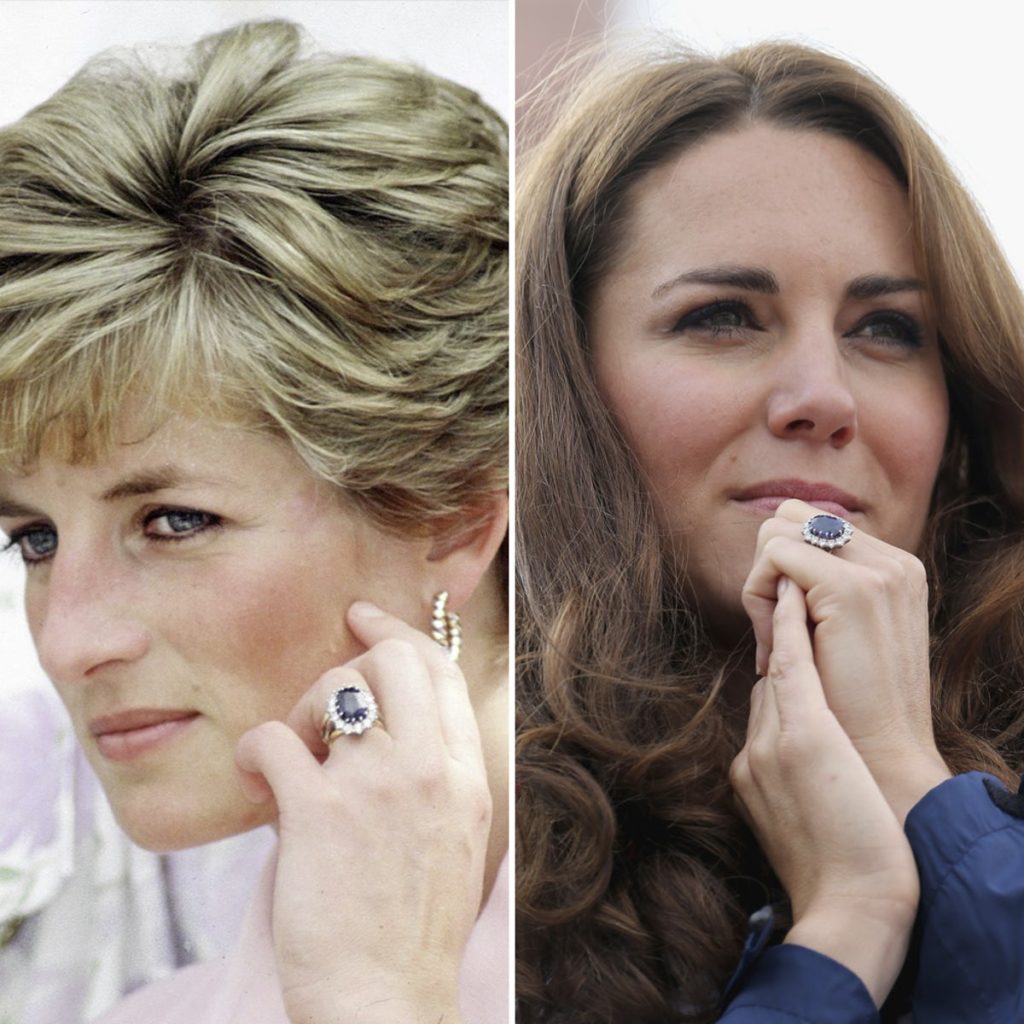For centuries, sapphires have been a gemstone prized by royalty, spiritual leaders, the wealthy and even alchemists and early physicians. Sought after by numerous cultures throughout world history for their unmatched beauty, mystical properties and once-purported healing abilities, the popularity of sapphires continues to transcend time and place. The sapphire is September's birthstone and has traditionally symbolized everything from nobility to romance and truth to faithfulness. One fact, however, remains constant: this extraordinary jewel’s royal blue hue sets the standard against which all other blue gemstones — from topaz to tanzanite — are judged.

Sapphire Mesh Bracelet
Sapphire History & Lore
The earliest known sapphire mines date to the Ancient Near East where both the Persians and Babylonians believed the world was balanced on a giant sapphire, reflected in the color of the heavens. Ancient Greeks named the stone, deriving “sapphire” from sapheiros (and the Latin saphirus) — both meaning “blue.” In the Ancient Mediterranean, Greek and Roman rulers were convinced that blue sapphires cast off envy and harm and were routinely inscribed with the head of Zeus or Jupiter, king of all Olympian gods. Legend has it that Helen of Troy even owned a large star sapphire, which was believed to hold the key to her infamous beauty and allure. King Solomon’s famous “Seal of Solomon” in Ancient Hebrew lore is said to have been a sapphire with supernatural command of occult spirits. Tradition holds that Moses’ 10 Commandments were written on tablets of sapphire so strong that a hammer swung against them would be smashed to pieces. In Medieval Europe, clergy wore royal blue sapphires to both suppress sinful carnal desire and as a symbol of heaven and eternal life. The practice inevitably led to this gem’s association with chastity, piety and repentance, as well as Saint Paul the Apostle. Since the sapphire was so strongly linked to fidelity, the gems were thought to change color when worn by the unfaithful. Thusly, the knights of the Crusades used sapphires — including the color-changing varieties! — to test the chastity of their wives upon returning from long campaigns. Lithotherapy, the pseudoscientific practice of using gemstones in medicine, also became quite popular during the Medieval Period. Clergymen and early physicians prescribed wearing sapphires to cure everything from colic to kidney disease, bad eyesight and outbursts of rage. Meanwhile, famed Italian explorer Marco Polo gifted sapphires to each ruler he entertained during his expeditions through Asia and the Near East, from Constantinople to Samarkand. Many of the large, deep blue Ceylon sapphires still in the Royal Venetian Treasuries today can be traced to Marco Polo’s world travels during the 13th and 14th centuries. The sapphire’s legendary association with fairytale romance and nobility was reinforced in 1981 when Britain’s Charles, the Prince of Wales, became engaged to the beloved “princess of the people” Lady Diana Spencer with a blue sapphire engagement ring. The ring was later given to Catherine, the Duchess of York (formerly Kate Middleton), by Diana’s son Prince William, Duke of Cambridge. Thus, a contemporary generation of sapphire lovers was born that has bridged the 20th and 21st centuries.

In a truly touching show of affection, William proposed to Kate using his mother, the late Princess Diana's sapphire engagement ring.
A Spectrum of Color
“Many clients are often surprised to learn that sapphires come in a wide range of colors, depending on the trace minerals present in the stone.” says George Peralta, jewelry sales manager at M.S. Rau. With a decade of experience in the diamonds and fine jewelry industry, Peralta provides M.S. Rau shoppers with vital knowledge and expertise in seeking the perfect jewelry pieces. “Sapphires are one of my favorite stones because of their versatility.” Sapphires are found in a wide range of color, from golden yellow sapphire and padparadscha (or “lotus flower”) pink to the coveted deep royal blue hue characteristic to the stone. Both sapphires and rubies are a variety of the mineral corundum, which is naturally transparent. Yet, a robust spectrum of color and saturation can occur in the stone depending on the other minerals present during the gem’s geologic formation. Click here to learn more about the sapphire’s sister stone, the ruby. As with any other gemstones, color makes a big impact on a sapphire’s rarity and value. While blue is the most recognizable color, the exact hue and level of saturation can impact its appraisal. “The spectrum of colors that sapphires are found in is truly a feat of nature,” Peralta explains. “Our finest example of this is our Oscar Heyman Multi-Color Sapphire Necklace set with 111.16 total carats of sapphires in almost every imaginable color.”

Pink Sapphire drop earrings that display a vivid, highly saturated color
Global Origins
Sapphires have been discovered in many geographic locations around the world. However, three locations produce the most beautiful and valued gemstones: Kashmir, Burma and Sri Lanka (formerly Ceylon). Mines in these regions have all historically produced the most exceptional stones for centuries, and gems with Southeast Asian origins are viewed as the gold standard for sapphire enthusiasts. Different geographic locations produce different color variations, such as the velvety “Cornflower Blue” sapphires commonly mined in Kashmir and Madagascar. Caused by the same rutile inclusions that create the asterism effect in star sapphires, the saturation of color in these gemstones is unmatched by sapphires from any other regions. The rarest of all sapphire varieties is the padparadscha sapphire, found in a distinct hue falling between shades of pink and orange. Once thought to be exclusive to the Sri Lankan region of the Indian Subcontinent, these unmistakably hued sapphires have recently been discovered in Madagascar and Tanzania. “The rarity of sapphires mined from these regions cannot be overstated,” explains Peralta. “Many of the mines in Kashmir have been depleted over the hundreds of years that they have been active. However, newer mines in Madagascar are producing equally stunning gems.”

An Orange Sapphire and Diamond Ring
Untreated Rarities
Most sapphires on the market have undergone heat treatments designed to clear up inclusions and enhance the vibrancy of their color. This process impacts the beauty of the stone and has a noticeable effect on price. “After working in the jewelry industry for 10 years, I’ve seen hundreds of sapphires, most of which have been heat treated to enhance their appearance,” says Peralta. Untreated or “no-heat” sapphires command premium prices because of their rarity and desirability. These scarce gems are often accompanied by a certificate issued by a gemological institute stating that there are no indications of treatment present. Determining whether a sapphire has been treated is extremely difficult, and most must be sent to specialized laboratories to be scientifically tested.

A Green Sapphire and Diamond Ring
Star Sapphires
Rare star sapphires stand apart for their “asterism” inclusions resembling a multi-pointed star. Thousands of minuscule rutile inclusions create this effect during a star sapphire’s geological formation. Asterisms in star sapphires are enhanced by the smooth, curvaceous surface of a cabochon cut trademark to these gorgeous gems. This 28.00-carat Cabochon Star Sapphire Ring is exemplary of this incredible phenomenon.

A royal blue star sapphire.
Sapphires have remained some of the most powerful and prized gemstones throughout the ages, inspiring legend and lore, adorning important figures and sparking new ways of thinking about medicine and spirituality. As a truly lasting gemstone, the ideal sapphire continues to captivate jewelry experts and consumers alike. Be sure to browse our extensive collection of antique sapphire jewelry for sale at M.S. Rau today.



